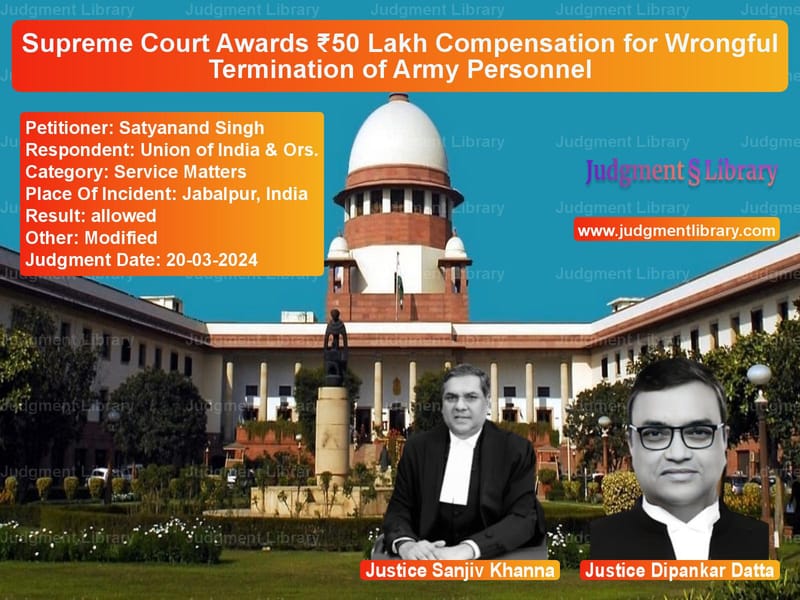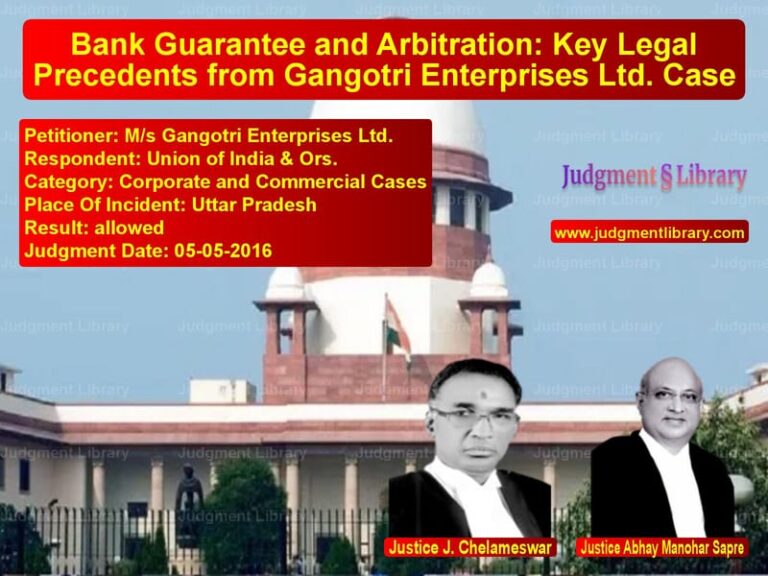Supreme Court Awards ₹50 Lakh Compensation for Wrongful Termination of Army Personnel
The Supreme Court of India recently ruled in the case of Satyanand Singh v. Union of India & Ors., delivering a landmark judgment regarding the wrongful termination of an army personnel based on an incorrect medical diagnosis. The Court not only set aside the termination but also awarded ₹50 lakh compensation for the mental agony, financial distress, and social stigma faced by the appellant.
Background of the Case
The appellant, Satyanand Singh, was enrolled in the Indian Army as a Havaldar on October 30, 1993. For several years, he served in a clerical post without any issues. However, in 1999, he started experiencing fever, headache, and vomiting, leading to medical evaluations at the Jabalpur Military Hospital. During the medical tests, the appellant was diagnosed as HIV-positive.
On January 9, 2000, the Army Headquarters issued a notice stating that personnel who were HIV-positive and suffering from tuberculosis would be considered as having AIDS. The appellant continued to undergo medical treatments, and in August 2001, he developed double vision, for which he was referred to the Command Hospital, Pune. Suspecting neuro-tuberculosis, the doctors treated him accordingly. A Medical Report dated September 14, 2001 officially diagnosed him with “AIDS defining illness in the form of neuro-tuberculosis.” This led to his classification as ‘P5’ (gross physical limitations), and he was invalided out of service.
On December 26, 2001, after 8 years and 58 days of service, the appellant was discharged under Rule 13(3), Item III(iii) of the Army Rules, 1954.
Legal Proceedings
The appellant challenged his termination through various legal channels:
- In 2003, the Army introduced new guidelines for HIV/AIDS management, which stated that a CD4 count below 200 cells/mm³ would be a defining condition for AIDS. The appellant’s CD4 count remained above this threshold.
- In 2006, the Madhya Pradesh High Court ruled in favor of the appellant, quashing his discharge order.
- In 2007, a Division Bench of the High Court reversed the earlier ruling, upholding the discharge.
- In 2009, the Supreme Court allowed the appellant to withdraw his appeal, directing him to seek statutory remedies.
- Subsequently, the appellant approached the Director General of Armed Forces Medical Service (DGAFMS) for a Review Medical Board, which was denied in 2009, citing the Army’s 1992 guidelines.
- Further appeals before the Armed Forces Tribunal (AFT) were rejected.
Petitioners’ Arguments
The appellant argued:
- The diagnosis of AIDS was incorrect, as his CD4 count was consistently above 200 cells/mm³.
- The Army’s 1992 guidelines were outdated and were replaced by the 2003 guidelines.
- He never exhibited symptoms of AIDS, nor did he require anti-retroviral therapy.
- The medical evaluation was flawed, as no neurologist examined him.
- His discharge was based on an erroneous assumption that he had a terminal illness.
- Despite being HIV-positive, he could have continued serving in a non-combat clerical role.
Respondents’ Arguments
The Union of India and Army authorities argued:
- The appellant was not discharged merely for being HIV-positive but because of his neuro-tuberculosis diagnosis.
- At the time of discharge, medical advancements were limited, and the decision was based on available knowledge.
- The appellant had responded to tuberculosis treatment, confirming the diagnosis.
- His condition made him unfit for military service, where physical fitness is crucial.
- Even if he was later found to be asymptomatic, the decision made in 2001 was legally valid.
Supreme Court’s Observations
The Supreme Court found multiple inconsistencies and procedural lapses in the appellant’s discharge:
- Wrong Diagnosis: The appellant never had tuberculosis, and his double vision was mistakenly interpreted as a sign of neuro-tuberculosis.
- Medical Negligence: No neurologist was part of the evaluation panel, leading to an incorrect diagnosis.
- Violation of 2003 Guidelines: His CD4 count was never below 200 cells/mm³, meaning he should not have been considered an AIDS patient.
- Denial of Review Medical Board: The rejection of his review request in 2009 was arbitrary and failed to consider updated medical guidelines.
- Social Stigma: The wrongful AIDS diagnosis subjected the appellant to unwarranted stigma, mental trauma, and professional ruin.
Key Judicial Remarks
The Supreme Court strongly condemned the handling of the appellant’s case:
“We have no doubt in our mind that this is a case of wrong diagnosis and false alarm with imperiling consequences for the appellant.”
On the Army’s failure to rectify the error, the Court remarked:
“The respondents had the opportunity from 2007 onwards to correct themselves, yet they chose to uphold a fundamentally flawed decision.”
Regarding social stigma, the Court stated:
“The appellant was forced to live with the unjustified tag of an AIDS patient, despite medical evidence proving otherwise.”
Final Judgment
The Supreme Court ruled:
- The appellant’s discharge was wrongful and based on an incorrect medical diagnosis.
- The Armed Forces Tribunal’s decision was set aside.
- The appellant was awarded ₹50 lakh in compensation for wrongful termination, social stigma, and mental trauma.
- The Army was directed to calculate and grant pension benefits as if the appellant had continued service until retirement as a Havaldar.
Conclusion
This judgment sets a precedent in cases where wrongful medical diagnoses lead to termination. It ensures that armed forces personnel are not unfairly discharged based on outdated medical assessments. The ruling highlights the importance of reviewing past decisions in light of evolving medical knowledge and upholding justice for affected individuals.
Petitioner Name: Satyanand Singh.Respondent Name: Union of India & Ors..Judgment By: Justice Sanjiv Khanna, Justice Dipankar Datta.Place Of Incident: Jabalpur, India.Judgment Date: 20-03-2024.
Don’t miss out on the full details! Download the complete judgment in PDF format below and gain valuable insights instantly!
Download Judgment: satyanand-singh-vs-union-of-india-&-ors-supreme-court-of-india-judgment-dated-20-03-2024.pdf
Directly Download Judgment: Directly download this Judgment
See all petitions in Employment Disputes
See all petitions in Disciplinary Proceedings
See all petitions in Pension and Gratuity
See all petitions in Judgment by Sanjiv Khanna
See all petitions in Judgment by Dipankar Datta
See all petitions in allowed
See all petitions in Modified
See all petitions in supreme court of India judgments March 2024
See all petitions in 2024 judgments
See all posts in Service Matters Category
See all allowed petitions in Service Matters Category
See all Dismissed petitions in Service Matters Category
See all partially allowed petitions in Service Matters Category







